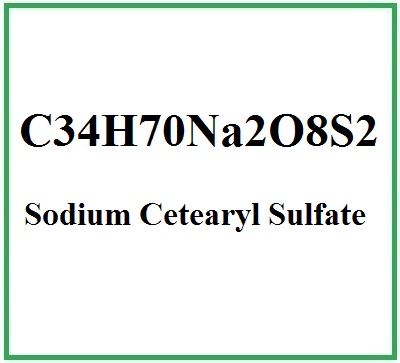Sodium Cetearyl Sulfate is a sodium salt derived from C16 Cetyl Alcohol and C18 Stearyl Alcohol.
Breakdown of the name and function of the components
- Sodium - Indicates the presence of sodium ions in the compound.
- Cetearyl - Combined reference to cetearyl alcohols, which are a blend of cetyl and stearyl alcohols.
- Sulfate - Indicates the presence of a sulfate group in the compound.
Description and function of the raw materials used in production
- Cetearyl alcohols - Derived mainly from fats and oils and serve as the foundation for the synthesis of the compound.
- Sulfuric acid or a similar sulfating agent - Used to introduce the sulfate group.
Summary of its industrial synthesis process step by step
- Reaction - The cetearyl alcohols are reacted with sulfuric acid to form cetearyl sulfate.
- Neutralization - The acidic product is then neutralized with a sodium solution, forming Sodium Cetearyl Sulfate.
- Purification - The product is purified to remove any impurities or unreacted substances.
- Drying - The Sodium Cetearyl Sulfate is then dried to remove any residual moisture.
What it is for and where
Cosmetics
It is used in cosmetics in soaps, cleansing creams and shampoos, as a surfactant, emulsifier to give consistency to the mixture.
Cleansing agent. Ingredient that cleanses skin without exploiting the surface-active properties that produce a lowering of the surface tension of the stratum corneum.
Foaming. Its function is to introduce gas bubbles into the water for a purely aesthetic factor, which does not affect the cleaning process, but only satisfies the commercial aspect of the detergent by helping to spread the detergent. This helps in the commercial success of a cleansing formulation. Since sebum has an inhibiting action on the bubble, more foam is produced in the second shampoo. In practice, it creates many small bubbles of air or other gases within a small volume of liquid, changing the surface tension of the liquid.
Foaming. Its function is to introduce gas bubbles into the water for a purely aesthetic factor, which does not affect the cleaning process, but only satisfies the commercial aspect of the detergent by helping to spread the detergent. This helps in the commercial success of a cleansing formulation. Since sebum has an inhibiting action on the bubble, more foam is produced in the second shampoo. In practice, it creates many small bubbles of air or other gases within a small volume of liquid, changing the surface tension of the liquid.
Surfactant - Cleansing agent. Cosmetic products used to cleanse the skin utilise the surface-active action that produces a lowering of the surface tension of the stratum corneum, facilitating the removal of dirt and impurities.
The concentration is variable: from 0.1% to 29%.
Regarding safety, it is a safe component when used in the doses mentioned above (1).
Sodium Cetearyl Sulfate studies
- Molecular Formula C34H70NaO8S2-
- Molecular Weight 694.036 g/mol
- CAS 59186-41-3
- EC Number: 611-809-9
Synonyms:
- Sodium cetostearyl sulfate
- Dehydag Wax E
- Sodium cetostearyl sulfate [NF]
- Sodium cetyl/stearyl sulfate
- Sulfuric acid, monooctadecyl ester, sodium salt, mixt. with sodium hexadecyl sulfate
- sodium; hexadecyl sulfate; octadecyl sulfate
- sodium; 1-sulfonatooxyhexadecane; 1-sulfonatooxyoctadecane
References_________________________________________________________________________
(1) Fiume M, Bergfeld WF, Belsito DV, Klaassen CD, Marks JG Jr, Shank RC, Slaga TJ, Snyder PW, Alan Andersen F. Final report on the safety assessment of sodium cetearyl sulfate and related alkyl sulfates as used in cosmetics. Int J Toxicol. 2010 May;29(3 Suppl):115S-32S. doi: 10.1177/1091581810364665.
Abstract. Sodium cetearyl sulfate is the sodium salt of a mixture of cetyl and stearyl sulfate. The other ingredients in this safety assessment are also alkyl salts, including ammonium coco-sulfate, ammonium myristyl sulfate, magnesium coco-sulfate, sodium cetyl sulfate, sodium coco/hydrogenated tallow sulfate, sodium coco-sulfate, sodium decyl sulfate, sodium ethylhexyl sulfate, sodium myristyl sulfate, sodium oleyl sulfate, sodium stearyl sulfate, sodium tallow sulfate, sodium tridecyl sulfate, and zinc coco-sulfate. These ingredients are surfactants used at concentrations from 0.1% to 29%, primarily in soaps and shampoos. Many of these ingredients are not in current use. The Cosmetic Ingredient Review (CIR) Expert Panel previously completed a safety assessment of sodium and ammonium lauryl sulfate. The data available for sodium lauryl sulfate and ammonium lauryl sulfate provide sufficient basis for concluding that sodium cetearyl sulfate and related alkyl sulfates are safe in the practices of use and concentration described in the safety assessment.
![]() Sodium Cetearyl Sulfate
Sodium Cetearyl Sulfate 

